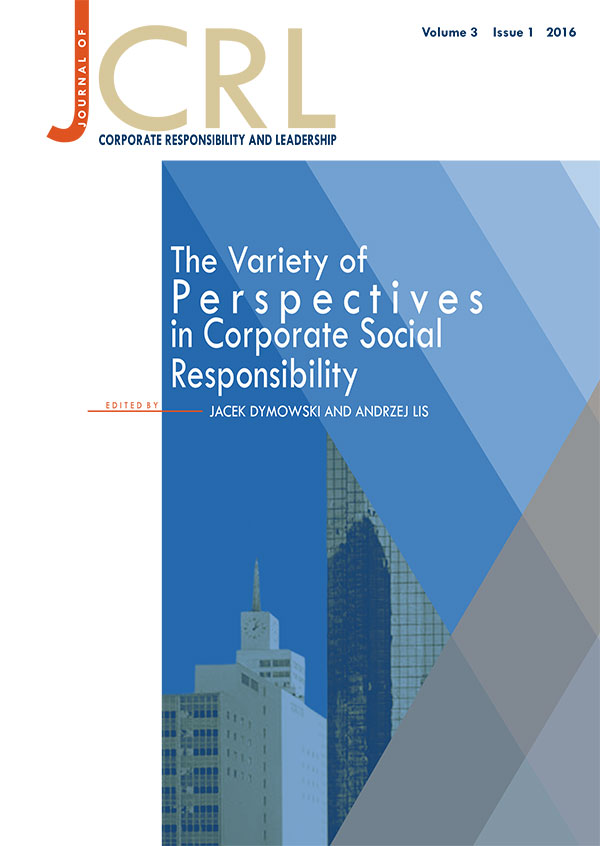NOT JUST SHOP – An Innovative and Socially Responsible Business Model: The Case Study
DOI:
https://doi.org/10.12775/JCRL.2016.001Keywords
business model, social responsibility of business, case study, innovationsAbstract
The article presents an example of a Europe-wide, innovative business model in the form of an I nternet store – NOT JUST SHOP. The examples of this business model can also be found in the United States. This is the first model of this sort in Europe. A similar business model is currently used in Switzerland. I ts objective is regular economic activity and seeking to make profit. This is nothing unusual. There are many companies like this. However, NOT JUST SHOP offers products the price of which includes an amount which goes to children, adults and other social groups in need. What is most important, the said amount is immediately available for the needy, not after achieving a profit. Moreover, customers of NOT JUST SHOP instantly see where their money goes and for which purpose. Consequently, there is full transparency. The presented case study is a guideline to create new innovative business solutions which lead not only to achieving profits, but also undertaking actions which are socially responsible.
References
Afuah, A., Tucci, C.L. (2001), Internet Business Models and Strategies, McGraw-Hill, New York.
“Arinova CSR Leader Thinking” (nd). Retrieved from http://efs.dolnyslask.pl/fileadmin/ user_upload/00014July/18d/Prezentacja_Beneficjenta.pdf (accessed 06 June 2016).
Blank, S., D orf, B. (2012), “9 Most I mportant Elements of Every Start-up”. Retrieved from http://www.inc.com/steve-blank/9-most-important-elements-successful-startups. html (accessed 06 June 2016).
“Business Model I nnovation” (nd). Retrieved from http://innovatika.pl/metody/business- model-innovation/ (accessed 06 June 2016).
“Corporate Social Responsibility” (nd). Retrieved from http://ec.europa.eu/growth/ industry/corporate-social-responsibility/index_en.htm (accessed 06 June 2016).
Creswell, J.W. (2013), Qualitative Inquiry and Research Design: Choosing among Five Approaches, SAGE, Thousand Oaks.
“Czy jedyną wartością w biznesie jest zysk?” (2013). Retrieved from http://prnews.pl/ wiadomosci/czy-jedyna-wartoscia-w-biznesie-jest-zysk-2928072.html (accessed 04 February 2016).
Fielt, E., (2013), “Conceptualising Business Models: D efinitions, Frameworks and Classifications”, Journal of Business Models, Vol. 1, No. 1, pp. 85 – 105.
George, G., Bock, A.J. (2011), “The Business Model in Practice and its I mplication for Entrepreneurship Research”, Entrepreneurship Theory and Practice, Vol. 35, Issue 1, pp. 83 – 111.
Gródek-Szostak, Z. (2012), “Model biznesowy źródłem przewagi innowacyjnej”. Retrieved from http://www.wsei.edu.pl/files/images/pracownicy/model_biznesowy_ r_d_em_przewagi_innowacyjnej_25_06_2012.pdf (accessed 01 February 2016).
Johansson, R. (2003), “Case Study Methodology”, keynote speech presented at the International Conference “Methodologies in Housing Research” organised by the Royal Institute of Technology in cooperation with the I nternational Association of People -Environment Studies, Stockholm, 22 – 24 September 2003. Retrieved from http:// www.psyking.net/htmlobj-3839/case_study_methodology-_rolf_johansson_ver_2. pdf (accessed 01 February 2016).
Koźmiński, A.K. (2004), Zarządzanie w warunkach niepewności: Podręcznik dla zaawansowanych, Wydawnictwo Naukowe PWN, Warszawa.
Ma, J., (2012), “A Study on the Models for Corporate Social Responsibility of Small and Medium Enterprises”, Physics Procedia, Vol. 25, pp. 435 – 442.
McWilliams, A., Siegel, D .S., Wright, P.M. (2006), “Corporate Social Responsibility: Strategic I mplications”, Journal of Management Studies, Vol. 43, I ssue 1, pp. 1 – 18.
Merriam, S.B. (2009), Qualitative Research: A Guide to Design and Implementation, Jossey-Bass, San Francisco.
Ministerstwo Gospodarki (nd), “CSR: Społeczna odpowiedzialność biznesu w Polsce”. Retrieved from http://www.mg.gov.pl/files/upload/10892/CSR_PL.pdf (accessed 06 June 2016).
Osterwalder, A., Pigneur Y. (2010), Business Model Generation: A Handbook for Visionaries, Game Changers and Challengers. Retrieved from http://www.businessmodelgeneration. com/downloads/businessmodelgeneration_preview.pdf (accessed 06 June 2016).
Pateli, A.G., Giaglis, G.M. (2004), “A Research Framework for Analysing eBusiness Models”, European Journal of Information Systems, Vol. 13, I ssue 4, pp. 302 – 314.
Rybak, M. (2004), Etyka menedżera – społeczna odpowiedzialność przedsiębiorstwa, PWN, Warszawa.
Stake, R.E. (1995), The Art of Case Study Research, SAGE, Thousand Oaks.
Stake, R.E. (1998), “Case Studies”, in: D enzin, N.K., Lincoln, Y.S. (Eds.), Strategies of Qualitative Inquiry, Vol. 2, Sage, Thousand Oaks.
Teece, D .J. (2010), “Business Models, Business Strategy and I nnovation”, Long Range Planning, Vol. 43, Issues 2 – 3, pp. 172 – 194.
Thomas, G. (2011), “A Typology for the Case Study in Social Science Following a Review of D efinition, D iscourse, and Structure”, Qualitative Inquiry, Vol. 17, Issue 6, pp. 511 – 521.
Zott, C., Amit, R. (2010), “Business Model D esign: An Activity System Perspective”, Long Range Planning, Vol. 43, Issues 2 – 3, pp. 216 – 226.
Downloads
Published
How to Cite
Issue
Section
Stats
Number of views and downloads: 398
Number of citations: 0



